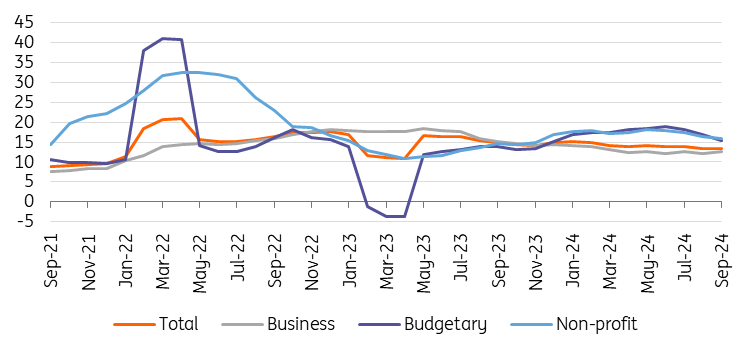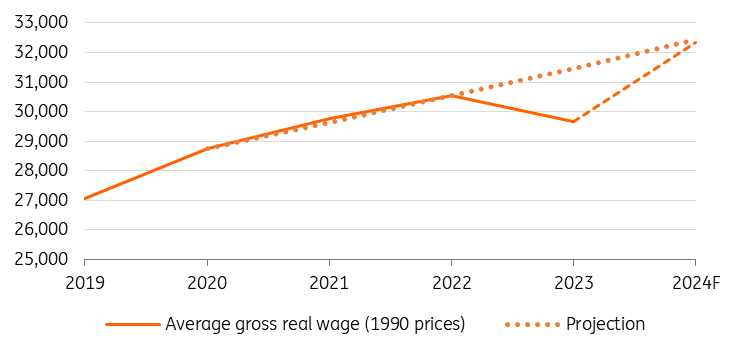 Image Source:
Image Source:
Average wage growth in Hungary decelerated in September, mainly due to a slowdown in the corporate and non-profit sectors. However, the strong momentum hasn’t yet been reflected in economic output.According to the latest data from the Hungarian Central Statistical Office (HSCO), average gross wages grew by 12.5% year-on-year in September 2024 after a slight slowdown. While this was below market consensus, there have been both positive and negative surprises in previous months, so it is more likely to be a case of general volatility.Today’s data point is in line with the longer-term trend of a slow but steady moderation in the pace of wage growth since the beginning of the year. Indeed, September’s wage dynamics have been the lowest so far this year, and this is the first time we have seen a rate below 13%. However, given that expectations at the beginning of the year were for wage growth to fall into single digits in the second half of the year, this figure remains very high.Wage dynamics (3-month moving average, % YoY) Source: HCSO, ING Looking at the September data in more detail, the slowdown in average wage growth is now mainly due to wage developments in the corporate and non-profit sectors. The latter is basically of minor importance, so it is more relevant to look at developments in the private sector.In this sector, the pace of wage growth slowed from 12.5% (August) to 11.9% YoY (September). There was also a general slowdown in the pace of wage growth in agriculture, industry, construction and market services. The real estate sector bucked the general trend and continued to record above-average wage growth. In the public sector, average wage growth remains very high at over 14%. This is due to wage agreements in various sectors, such as education and healthcare.Nominal and real wage growth (% YoY)
Source: HCSO, ING Looking at the September data in more detail, the slowdown in average wage growth is now mainly due to wage developments in the corporate and non-profit sectors. The latter is basically of minor importance, so it is more relevant to look at developments in the private sector.In this sector, the pace of wage growth slowed from 12.5% (August) to 11.9% YoY (September). There was also a general slowdown in the pace of wage growth in agriculture, industry, construction and market services. The real estate sector bucked the general trend and continued to record above-average wage growth. In the public sector, average wage growth remains very high at over 14%. This is due to wage agreements in various sectors, such as education and healthcare.Nominal and real wage growth (% YoY) Source: HCSO, ING The gap between the national average wage and the median wage has continued to narrow, which may be partly due to the increase in the minimum wage and the retreat of the shadow economy. In addition, growth in regular earnings has been more dynamic (albeit minimal) than in the data with bonuses, so it is likely that (at least partially) developments in one-off payments are behind the slowdown in wage growth in some areas of the private sector. The growth rate of real earnings remains above 9% YoY, which can be considered quite high. However, the positive effects of this are not yet being felt in the economy, as households’ propensity to save is high and caution remains strong.On the basis of the data, we believe that the dynamic wage growth in the competitive sector could continue in the fourth quarter which, taking into account changes in the public and non-profit sectors, should almost certainly lead to average wage growth of over 13% for the economy as a whole. This, together with a gradual unwinding of household caution and stronger demand, could also increase the pricing power and willingness of firms. However, this mainly reflects inflationary risks next year rather than this year.The level of average gross real wage (1990 CPI adjusted HUF)
Source: HCSO, ING The gap between the national average wage and the median wage has continued to narrow, which may be partly due to the increase in the minimum wage and the retreat of the shadow economy. In addition, growth in regular earnings has been more dynamic (albeit minimal) than in the data with bonuses, so it is likely that (at least partially) developments in one-off payments are behind the slowdown in wage growth in some areas of the private sector. The growth rate of real earnings remains above 9% YoY, which can be considered quite high. However, the positive effects of this are not yet being felt in the economy, as households’ propensity to save is high and caution remains strong.On the basis of the data, we believe that the dynamic wage growth in the competitive sector could continue in the fourth quarter which, taking into account changes in the public and non-profit sectors, should almost certainly lead to average wage growth of over 13% for the economy as a whole. This, together with a gradual unwinding of household caution and stronger demand, could also increase the pricing power and willingness of firms. However, this mainly reflects inflationary risks next year rather than this year.The level of average gross real wage (1990 CPI adjusted HUF) Source: HCSO, ING We expect average annual wage growth of 13.0-13.5% this year and average inflation of 3.6-3.7% in 2024. For the year as a whole, real wage growth could therefore be as high as 9%. While this looks very strong, it would only mean that, on top of last year’s fall in real wages, the purchasing power of average wages would be around 6% higher than the real wage level in 2022. In other words, we would still prefer to describe this year’s development as a wage catch-up in the light of the sharp fall in 2023.More By This Author:
Source: HCSO, ING We expect average annual wage growth of 13.0-13.5% this year and average inflation of 3.6-3.7% in 2024. For the year as a whole, real wage growth could therefore be as high as 9%. While this looks very strong, it would only mean that, on top of last year’s fall in real wages, the purchasing power of average wages would be around 6% higher than the real wage level in 2022. In other words, we would still prefer to describe this year’s development as a wage catch-up in the light of the sharp fall in 2023.More By This Author:
Hungarian Wage Growth Moderates But Remains Strong

